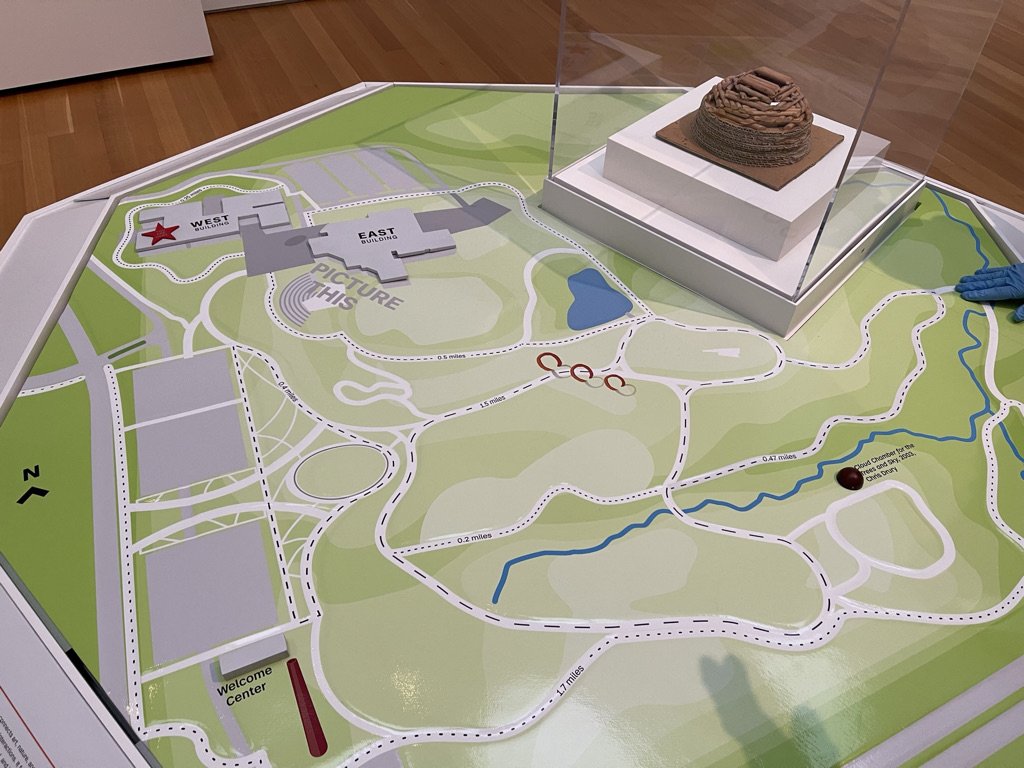Photo ID: Entrance to the NCMA. The glass-walled, modern building appears through a courtyard planted with trees.
Address
2110 Blue Ridge Rd
Raleigh, NC 27607
Telephone
(919) 715-5923
Website
To read a summary of the blog, please click the In Short button.
WHAT I LIKED: I really appreciated that so many thoughts were put forward to make a visit to the museum a rewarding one for all people.
WHAT I MISSED: an audio guide for the collection.
About the Museum
One of our rare road trips in the past few years took us on a route from Raleigh, NC to Atlanta, GA, and naturally our first stop was the North Carolina Museum of Art.
The location of the museum is conveniently placed for a road trip: next to the interstate. The museum complex lies in the middle of a landscaped sculpture park with rolling hills—a very welcoming sight.
In 1924, the North Carolina Art Society was formed with the mission to generate interest in creating an art museum for the state of North Carolina. After acquiring several collections and receiving funding from the state, the Museum finally opened in 1947 in downtown Raleigh.
After outgrowing the first location, a new Museum was opened in 1983 at the current location. Edward Durell Stone (also architect of the Kennedy Center in Washington, DC, the Museum of Modern Art in New York, and the Legislative Building in downtown Raleigh) and Holloway-Reeves Architects of North Carolina designed the new building (now called East Building) using the geometric form of a square as a basic unit for the entire site.
In the 2000s the need for even more space led to the design of a new gallery building (now called West Building) by architects Thomas Phifer and Partners with environmental consciousness in mind.
The 164-acre Museum Park offers community spaces, forests, meadows, a theater, site-specific installations, and a permanent exhibition of sculptures with a variety of programs offered on the grounds.
The museum’s collection was slowly built up with gifts of private collections and its own acquisitions. Now the collection ranges from Greek, Roman, and Egyptian Art to paintings from the Renaissance to the 19th century, from African, early American and Judaic to Contemporary Art.
Photo ID:
A painting by Claude Monet (French, 1840-1926).
The Cliff, Étretat, Sunset
1882-1883
Oil on canvas
Monet composed this serene painting while staying in the resort town of Étretat on the northern coast of France. He created its hazy atmosphere by overlapping dashes of blues, greens, pinks, and oranges. Monet’s sketch-like approach was controversial in its time. He was repeatedly rejected from state-sponsored Salons and started exhibiting independently with a group known as the impressionists, whose works were often critiqued harshly.
These artists used hasty, fragmented brushstrokes that seem to provide viewers with a momentary glimpse of a given subject. Their interest in modern life and pure landscape marked a radical shift from their contemporaries.
–Michele Federick, Associate Curator of European Art and Provenance Research
Entrance and Galleries
The clear layout of the buildings and the natural light in many of the galleries make you feel welcome and give you a sence of calmness. There is enough space between the artworks, so you do not have to worry too much if you might hit an artwork with your cane (if you are using one) while you are visiting. Good signage makes navigating the space easy. The light was very comfortable for me, though please always remember that this might be different for everyone.
Photo ID:
Touching a Bust of Rodin
Modeled 1888-1892, date of cast unknown
Bronze
Camille Claudel
French, 1864-1943
Labels and Audio Guide
I was very lucky to have asked for a private verbal description tour a couple of weeks prior to my visit and so my husband and I had the opportunity to take a tour with an experienced educator and a nice lady from the access team. I was able to touch many objects with gloves (it was great to touch Rodin’s head by Camille Claudel) and enjoy artworks through verbal description—always so precious to me!
The labels were well-placed and in a good font for me.
There are several touch objects for all visitors to explore, like textures of Impressionism and a 3D touch map of the Museum and the Museum Park. There is even a sound and wind installation that will enhance your experience of the artwork.
An interactive digital replica lets you explore the artwork Allegorical Portrait of an Artist in Her Studio by Michiel van Musscher, ca. 1675, with the possibility to touch a screen and listen to detailed descriptions and information about the artwork.
This was the first time I experienced such a digital replica and it was informative and a lot of fun!
An audio guide for the Museum Park is available at the Apple app store, on the website, and on SoundCloud.
Photo ID: 3D touch map of the museum and park
Photo ID: Digital replica, Allegorical Portrait of an Artist in Her Studio by Michiel van Musscher, ca. 1675
Last, But Not Least
My visit to this museum was a great success. I enjoyed a wonderful verbal description tour and was able to explore the galleries and several touch objects in a calm and easy-to-navigate environment. I love the mission of the museum and the staff members to make a visit possible for all people with or without special needs.
Next time I will spend more time in the park as it is beautifully landscaped and displays interesting artwork.




